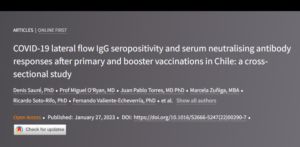Denis Sauré, PhD, Prof Miguel O’Ryan, MD, Juan Pablo Torres, MD PhD, Marcela Zuñiga, MBA
Ricardo Soto-Rifo, PhD, Fernando Valiente-Echeverría, PhD, et al.
Summary
Background
By June 30, 2022, 92·6% of the Chilean population older than 18 years had received a full primary SARS-CoV-2 vaccine series, mostly with CoronaVac (Sinovac Biotech), and 78·4% had received a booster dose, mostly heterologous with BNT162b2 (Pfizer–BioNTech) and ChAdOx1 (AstraZeneca). We previously reported national seroprevalence data from lateral flow testing of IgG SARS-CoV-2 antibodies up to 16 weeks after primary vaccination. Our aim here was to study IgG seropositivity dynamics up to 30 weeks after primary vaccination and, in CoronaVac recipients, up to 26 weeks after booster vaccination, and to establish the correlation between lateral flow tests and neutralising antibody titres.
Methods
In this cross-sectional study, testing stations for SARS-CoV-2 IgG detection were selected and installed from March 12, 2021, in hotspots in 24 large Chilean cities, and were maintained until March 31, 2022. Individuals voluntarily approaching the testing stations were invited to perform a rapid lateral flow test via a finger prick and complete a questionnaire. Between Aug 12, 2021, and April 1, 2022, volunteers seeking medical care in the Mutual de Seguridad de la Cámara Chilena de la Construcción provided blood samples for lateral flow testing and neutralising antibody studies; inclusion criteria were age at least 18 years, history of complete primary vaccination series with CoronaVac, BNT162b2, or ChAdOx1, or no vaccine, and no previous COVID-19 diagnosis. We tested the difference in IgG positivity across time, and between primary and booster doses, in all eligible participants with complete records, controlling for age, gender, and comorbidities. We also assessed the predictive power of neutralising antibody titres and sociodemographic characteristics on the probability of IgG positive results using multivariable logistic regression.
Findings
Of 107 220 individuals recruited at the testing stations, 101 070 were included in our analysis (59 862 [59·2%] women and 41 208 [40·8%] men). 65 902 (65·2%) received primary vaccination series with CoronaVac, 18 548 (18·4%) with BNT162b2, and 606 (0·6%) with ChAdOx1, and 16 014 (15·8%) received no vaccine. Among the 61 767 individuals with a complete primary vaccination series with CoronaVac, 608 (1·0%) received a CoronaVac booster, 10 095 (16·3%) received a BNT162b2 booster, and 5435 (8·8%) received a ChAdOx1 booster. After ChAdOx1 primary vaccination, seropositivity peaked at week 5 after the second dose, occurring in 13 (92·9%, 95% CI 79·4–100·0) of 14 individuals. In participants who received a complete CoronaVac primary series, the decline in seropositivity stabilised at week 18 after the second dose (86 [44·7%, 95% CI 41·8–47·7] of 1087 individuals), whereas after receiving BNT162b2, seropositivity declined slightly by week 25 after the second dose (161 [94·2%, 90·6–97·7] of 171). A lower proportion of individuals who received the CoronaVac primary series and a homologous booster were seropositive (279 [85·6%, 95% CI 81·8–89·4] of 326) by weeks 2–18 than those who received a BNT162b2 booster (7031 [98·6%, 98·4–98·9] of 7128) or a ChAdOx1 booster (2893 [98·0%, 97·5–98·5] of 2953). The correlation between IgG positivity and log of the infectious dose in 50% of neutralising antibodies was moderate, with a sensitivity of 81·4% (95% CI 76·3–86·6) and specificity of 92·5% (73·3–100·0).
Interpretation
Dynamic monitoring of IgG positivity to SARS-CoV-2 can characterise antibody waning over time in the absence or presence of booster doses, providing relevant data for the design of vaccination strategies. The correlation between lateral flow test IgG titres and neutralising antibody concentrations suggests that they could be a quick and effective surveillance tool to measure protection against SARS-CoV-2.
Funding
Instituto Sistemas Complejos de Ingeniería, Subsecretaría de Redes Asistenciales, Ministry of Health, Chile, and Mutual de Seguridad de la Cámara Chilena de la Construcción.
